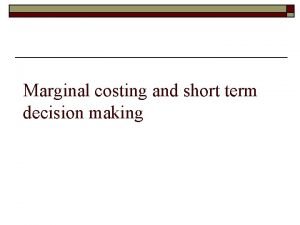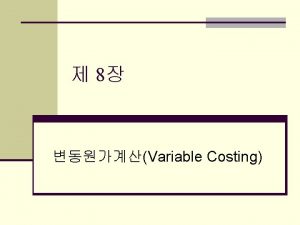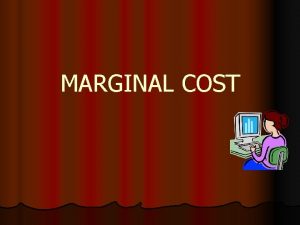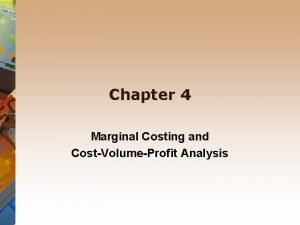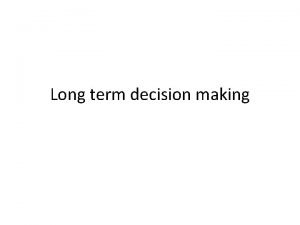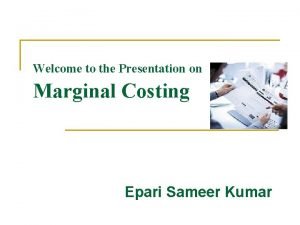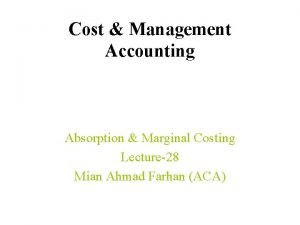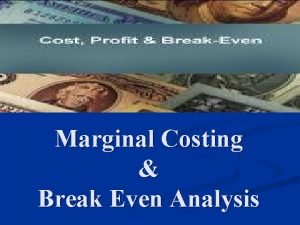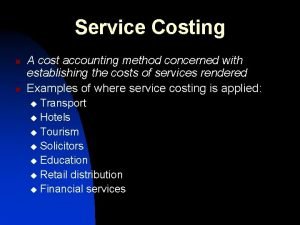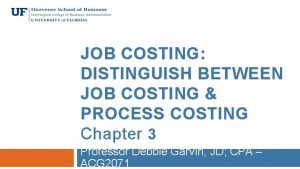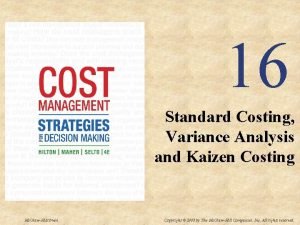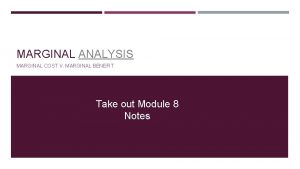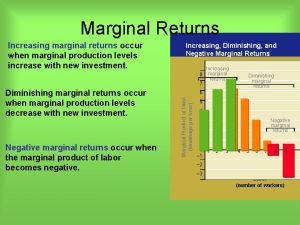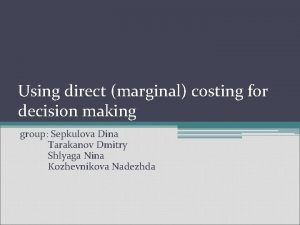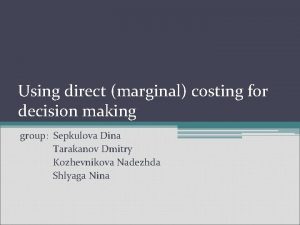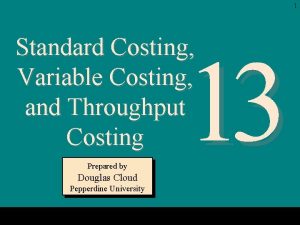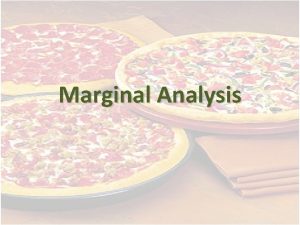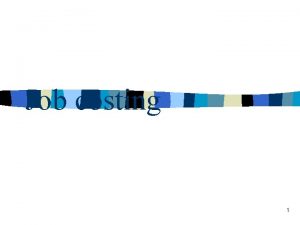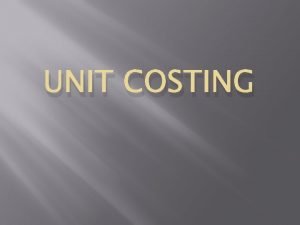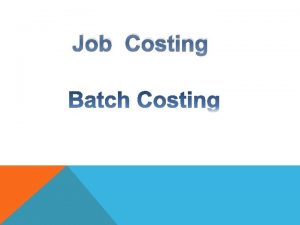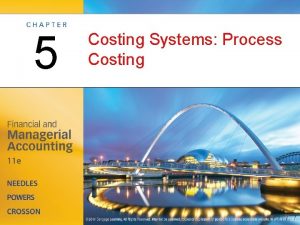Marginal costing and short term decision making What




















- Slides: 20

Marginal costing and short term decision making

What is Marginal Costing? The Marginal Costing method (Marginal costing) is a costing model that includes only the variable manufacturing costs: -direct materials (those materials that become an integral part of a finished product and can be conveniently traced into it) -direct labor (those factory labor costs that can be easily traced to individual units of product. Also called touch labor) - only variable manufacturing overhead in the cost of a unit of product. The entire amount of fixed costs are expenses in the year incurred.

Marginal costing format o o Marginal costing is technique use to make short term decision. Marginal costing assumes that variable cost is the only cost that can change by any decision. Fixed cost may not changed in the short run. Therefore its not a relevant cost for the decision.

Short term decisions o o Break even analysis Limiting factor analysis Accepting a special orders Discounting a loss making business or product

Management Accounting Breakeven Analysis

Breakeven Analysis Defined o o Breakeven analysis examines the short run relationship between changes in volume and changes in total sales revenue, expenses and net profit Also known as C-V-P analysis (Cost Volume Profit Analysis)

Uses of Breakeven Analysis o o o C-V-P analysis is an important tool in terms of short -term planning and decision making It looks at the relationship between costs, revenue, output levels and profit Short run decisions where C-V-P is used include choice of sales mix, pricing policy etc.

Decision making and Breakeven Analysis: Examples q o o o How many units must be sold to breakeven? How many units must be sold to achieve a target profit? Should a special order be accepted? How will profits be affected if we introduce a new product or service?

Key Terminology: Breakeven Analysis o o Break even point-the point at which a company makes neither a profit or a loss. Contribution per unit-the sales price minus the variable cost per unit. It measures the contribution made by each item of output to the fixed costs and profit of the organisation.

Key Terminology ctd. o o Margin of safety-a measure in which the budgeted volume of sales is compared with the volume of sales required to break even Marginal Cost – cost of producing one extra unit of output

Breakeven Formula Fixed Costs *Contribution per unit = Selling Price per unit – Variable Cost per unit

Breakeven Chart

Margin of Safety o o o The difference between budgeted or actual sales and the breakeven point The margin of safety may be expressed in units or revenue terms Shows the amount by which sales can drop before a loss will be incurred

Example 1 Using the following data, calculate the breakeven point and margin of safety in units: q Selling Price = € 50 o Variable Cost = € 40 o Fixed Cost = € 70, 000 o Budgeted Sales = 7, 500 units

Example 1: Solution o o o Contribution = € 50 - € 40 = € 10 per unit Breakeven point = € 70, 000/€ 10 = 7, 000 units Margin of safety = 7500 – 7000 = 500 units

Target Profits o o o What if a firm doesn’t just want to breakeven – it requires a target profit Contribution per unit will need to cover profit as well as fixed costs Required profit is treated as an addition to Fixed Costs

Example 2 Using the following data, calculate the level of sales required to generate a profit of € 10, 000: o Selling Price = € 35 o Variable Cost = € 20 o Fixed Costs = € 50, 000

Example 2: Solution o o Contribution = € 35 – € 20 = € 15 Level of sales required to generate profit of € 10, 000: € 50, 000 + € 10, 000 € 15 4000 units

Limitations of B/E analysis o o o o Costs are either fixed or variable Fixed and variable costs are clearly discernable over the whole range of output Production = Sales One product/constant sales mix Selling price remains constant Efficiency remains unchanged Volume is the only factor affecting costs

Reading o o o Drury, Colin Costing an Introduction (Chapters 19/20/21) Mc. Keon Murray Costing and Budgeting (Section 13) Luby, Alice Cost and Management Accounting (Section 3)
 Short term decision making in management accounting
Short term decision making in management accounting Tall + short h
Tall + short h Marginal costing and absorption costing
Marginal costing and absorption costing Marginal costing meaning
Marginal costing meaning Margin of safety formula business
Margin of safety formula business Objectives of decision making
Objectives of decision making Slidetodoc.com
Slidetodoc.com Long term decision making
Long term decision making Slidetodoc
Slidetodoc In stock
In stock Marginal costing and break even analysis
Marginal costing and break even analysis Short, medium and long term planning in education
Short, medium and long term planning in education Short term human resources
Short term human resources Difference between long term and short term liabilities
Difference between long term and short term liabilities Difference between long term and short term liabilities
Difference between long term and short term liabilities Example of long term plans
Example of long term plans Research paper on financial planning and forecasting
Research paper on financial planning and forecasting Service costing examples
Service costing examples How to find manufacturing overhead
How to find manufacturing overhead Contract costing definition
Contract costing definition Difference between standard costing and kaizen costing
Difference between standard costing and kaizen costing
